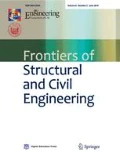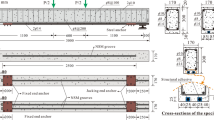Abstract
In this study, we conducted experimental tests on two specimens of reinforced concrete beams using a three-point bending test to optimize the flexure and stiffness designs. The first specimen is a reinforced concrete beam with an ordinary reinforcement, and the second specimen has an invented reinforcement system that consists of an ordinary reinforcement in addition to three additional bracings using steel bars and steel plates. The results of the flexure test were collected and analyzed, and the flexural strength, the rate of damage during bending, and the stiffness were determined. Finite element modeling was applied for both specimens using the LS-DYNA program, and the simulation results of the flexure test for the same outputs were determined. The results of the experimental tests showed that the flexural strength of the invented reinforcement system was significantly enhanced by 15.5% compared to the ordinary system. Moreover, the flexural cracks decreased to a significant extent, manifesting extremely small and narrow cracks in the flexure spread along the bottom face of the concrete. In addition, the maximum deflection for the invented reinforced concrete beam decreased to 1/3 compared to that of an ordinary reinforced concrete beam. The results were verified through numerical simulations, which demonstrated excellent similarities between the flexural failure and the stiffness of the beam. The invented reinforcement system exhibited a high capability in boosting the flexure design and stiffness.
Similar content being viewed by others
References
Jusoh W A W, Ibrahim I S, Sam A M. Flexural behavior of reinforced concrete beams with discrete steel-polypropylene fibers. MATEC Web of Conferences, 2017, 101: 01020
Isa M N. Flexural improvement of plain concrete beams strengthened with high performance fiber reinforced concrete. Nigerian Journal of Technology, 2017, 36(3): 697–704
Adom-Asamoah M, Wiafe Ampofo J, Afrifa R O. Flexural and shear behavior of reinforced concrete beams made from recycled materials. Journal of Ghana Institution of Engineers, 2009, 6(1): 57–66
Rabczuk T, Bordas S, Zi G. On three-dimensional modelling of crack growth using partition of unity methods. Computers & Structures, 2010, 88(23–24): 1391–1411
Rabczuk T, Zi G, Bordas S, Nguyen-Xuan H. A simple and robust three-dimensional cracking-particle method without enrichment. Computer Methods in Applied Mechanics and Engineering, 2010, 199(37–40): 2437–2455
Rabczuk T, Belytschko T. A three dimensional large deformation meshfree method for arbitrary evolving cracks. Computer Methods in Applied Mechanics and Engineering, 2007, 196(29–30): 2777–2799
Rabczuk T, Belytschko T. Cracking particles: A simplified meshfree method for arbitrary evolving cracks. International Journal for Numerical Methods in Engineering, 2014, 61(13): 2316–2343
Rabczuk T, Zi G, Bordas S, Nguyen-Xuan H. A geometrically nonlinear three dimensional cohesive crack method for reinforced concrete structures. Engineering Fracture Mechanics, 2008, 75(16): 4740–4758
Shishegaran A, Ghasemi M R, Varaee H. Performance of a novel bent-up bars system not interacting with concrete. Frontiers of Structural and Civil Engineering, 2019, 13(6): 1301–1315
Mohammad R G, Aydin S. Role of slanted reinforcement on bending capacity SS beams. Vibroengineering procedia, 2017, 11: 195–199
Namdar A, Darvishi E, Feng X. Effect of Flexural crack on plain concrete beam failure mechanism a numerical simulation. Fracture and Structural Integrity, 2016, 36: 168–181
Masmoudi A, Ben Ouezdou M, Haddar M. Mode of failure for reinforced concrete beams with GFRP bars. Journal of Theoretical and Applied Mechanics, 2016, 54(4): 1137–1146
Gomes L D D S, Oliveira D R C D, Moraes Neto B N D, Medeiros A B D, Macedo A N. Experimental analysis of the efficiency of steel fibers on shear strength of beams. Latin American Journal of Solids and Structures, 2018, 15(7): 1–16
Sudarsana K, Sajana P C, Gusti N O S. Applications of bolted steel plates to shear strengthening of RC beams. MATEC Web of Conferences, 2019, 276: 01002
Chen W F. Elasticity and Plasticity. Beijing: Chinese Architecture and Building Press, 2003
Perez N. Fracture Mechanics. Amsterdam: Kluwer Academic Publishers, 2004
Ziara M M. The Influence of Confining the Compression Zone in the Design of Structural Concrete Beams. Edinburgh: Heriot-Watt University, 1993
Livermore Software Technology Corporation. LS-DYNA Theory Manual. Livermore, CA: LSTC, 2020
Muttoni A. Punching shear strength of reinforced concrete slabs without transverse reinforcement. ACI Structural Journal, 2008, 105: 440–450
Mutton A, Ruiz M F. Shear strength of members without transverse reinforcement as function of critical shear crack width. ACI Structural Journal, 2008, 105: 163–172
Murray Y D. User’s Manual for LS-DYNA Concrete Material Model 159. FHWA-HRT-05-062. 2007
Murray Y D, Abu-Odeh A, Bligh R. Evaluation of Concrete Material Model 159. FHWA-HRT-05-063. 2007
Acknowledgements
This study was conducted with the financial support from the project GACR 17-23578S “Damage Assessment Identification for Reinforced Concrete Subjected to Extreme Loading” provided by the Czech Science Foundation. Furthermore, we acknowledge the cooperation of the civil engineering department of Tishk International University-Sulaimani in the Kurdistan Region of Iraq, who granted us official permission to conduct the experimental tests on the two specimens at their concrete laboratory.
Author information
Authors and Affiliations
Corresponding author
Rights and permissions
About this article
Cite this article
Nariman, N.A., Husek, M., Mohammad, I.I. et al. Analysis of stiffness and flexural strength of a reinforced concrete beam using an invented reinforcement system. Front. Struct. Civ. Eng. 15, 378–389 (2021). https://doi.org/10.1007/s11709-021-0706-z
Received:
Accepted:
Published:
Issue Date:
DOI: https://doi.org/10.1007/s11709-021-0706-z




